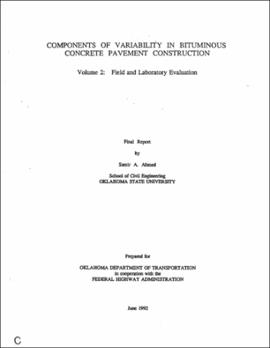| dc.creator | Ahmed, Samir A. | |
| dc.date.accessioned | 2018-09-06T21:52:16Z | |
| dc.date.available | 2018-09-06T21:52:16Z | |
| dc.date.issued | 1992-6 | |
| dc.identifier.govdoc | FHWA-OK-92-07 | |
| dc.identifier.other | Oklahoma Department of Transportation State Planning and Research 2179 | |
| dc.identifier.uri | https://hdl.handle.net/11244/301645 | |
| dc.description.abstract | The objectives of phase-II of the project were: 1) to detennine the components of the total variability in the measured quality attributes of acceptable bituminous concrete pavement construction in Oklahoma, 2) to assess the ODOT's specification tolerances for bituminous concrete pavement construction, 3) to evaluate the accuracy of the nuclear density gauge, and 4) to correlate the results of the nuclear test method for asphalt content detennination with those obtained using the solvent extraction method. To meet these objectives, a research plan consisting of literature review, statistical experimental design, field sampling, and laboratory testing was adopted. Random sampling was conducted both at the production plant and the roadway independent of acceptance and job control sampling. Testing was perfonned in the materials laboratories of the different ODOT Divisions. ANOV A results indicated that sampling and testing variances represent a significant portion of the total observed variance in the measured quality attributes of bituminous concrete pavement construction. The computed percentages within QNQC specification tolerances indicated that the present tolerances are practical and defensible. Correlations between density measurements obtained from the nuclear gauge and core samples ranged from 0.49 to 0.84. The use of calibrated relationships though regression analysis improved the estimation of core densities from nuclear measurements. Variability due to sampling and testing was largerin the core method than the nuclear gauge method. The correlation coefficient between individual asphalt content measurements using the extraction method and the nuclear gauge method was 0.63. No significant difference was found between the average asphalt content obtained from the extraction method and the average asphalt content obtained using the nuclear gauge method. Testing variability was less with the nuclear gauge method than the solvent extraction method. | |
| dc.format.extent | 164 pages | |
| dc.format.extent | 25,517,943 bytes | |
| dc.format.medium | application.pdf | |
| dc.language | en_US | |
| dc.relation.ispartofseries | No | |
| dc.relation.requires | Adobe Acrobat Reader | |
| dc.title | Components of variability in bituminous concrete pavement construction Volume II - Field and laboratory evaluation (FHWA-OK-92-07) 2179 | |
| dc.type | Technical Report | |
| dc.description.version | Final Report | |
| dc.description.peerreview | No | |
| dc.type.material | text | |
| dc.subject.keywords | Bituminous pavement | |
| dc.subject.keywords | Specifications | |
| dc.subject.keywords | Materials variance | |
| dc.subject.keywords | Sampling variance | |
| dc.subject.keywords | Testing variance | |
| dc.subject.keywords | Quality assurance | |
| dc.subject.keywords | Quality control | |
| dc.contributor.sponsor | Oklahoma Department of Transportation. Materials and Research Division. Office of Research & Implementation | |
